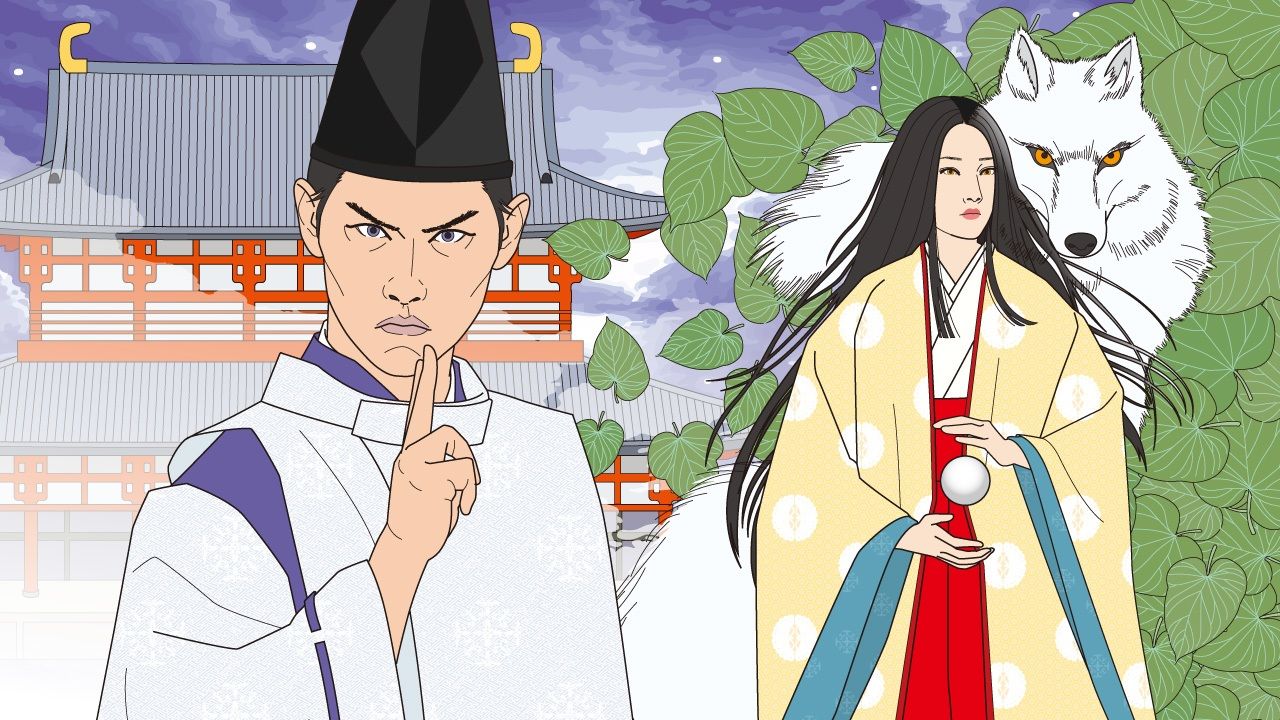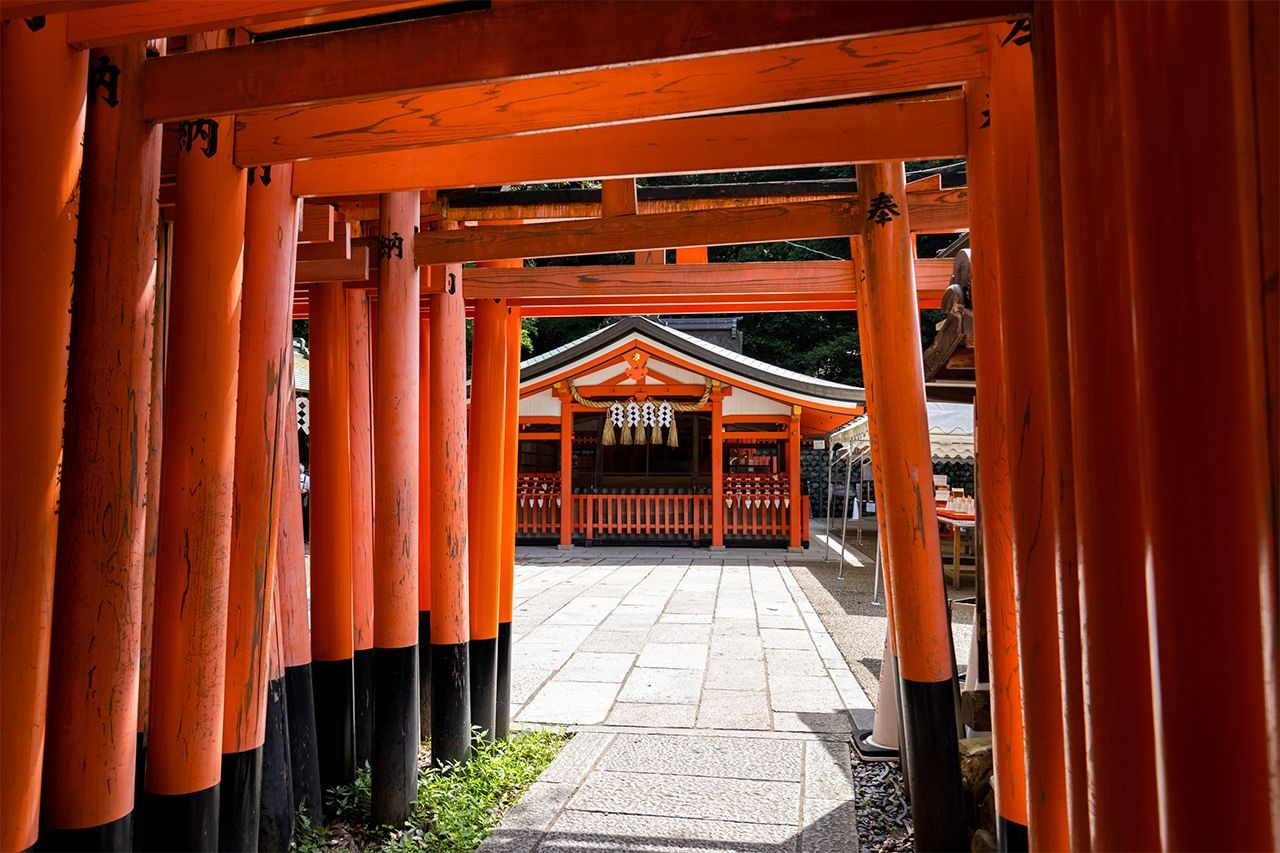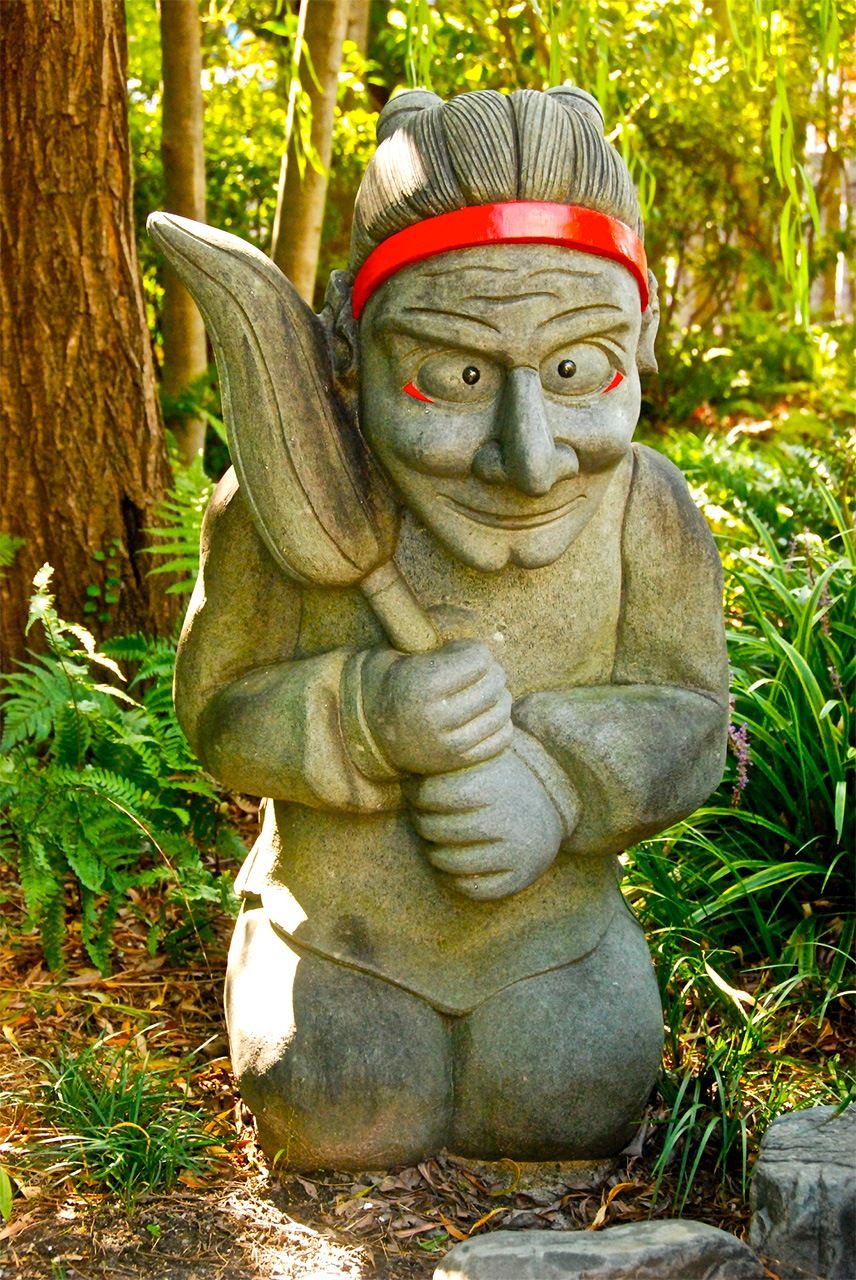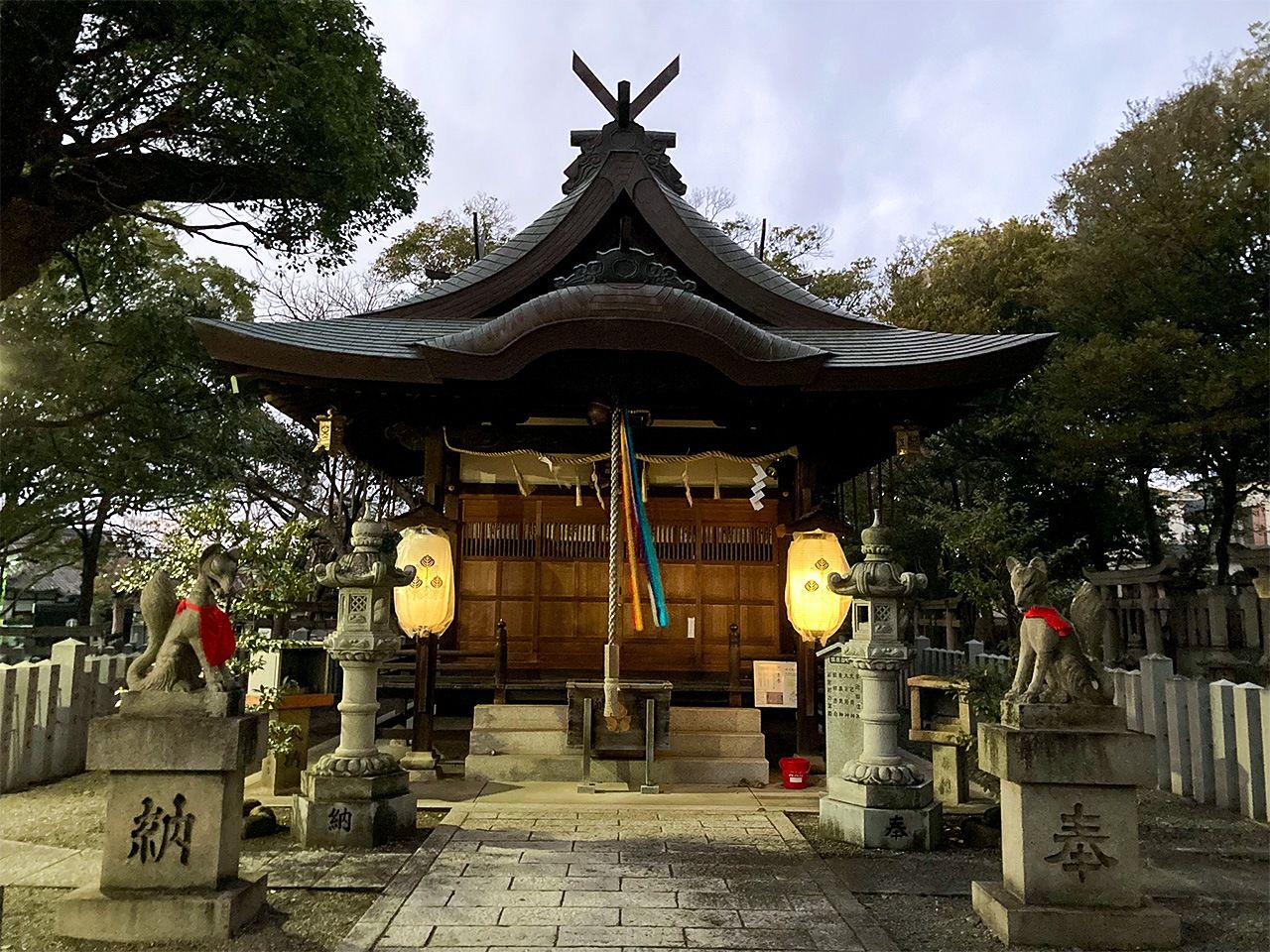
The Gods of Japanese Myths and Legends
Foxes, Inari Shrines, and Abe no Seimei
Guide to Japan Culture Lifestyle History- English
- 日本語
- 简体字
- 繁體字
- Français
- Español
- العربية
- Русский
Prayers for Harvest and Commerce
Shintō shrines dedicated to the deity Inari are found across Japan. Recognizable by their vermillion gates, they range from small structures tucked away in back alleys or placed on company rooftops to grand structures boasting snaking rows of bright red torii. Their numbers are second only to shrines dedicated to Hachiman, the patron deity of warriors. But whereas the latter grew in prominence through the support of the powerful warrior class, Inari shrines became popular among commoners through their association with rice cultivation and commerce.
Inari is identified with Ukanomitama, a god of rice who appears alongside the myriad other kami of Japanese mythology described in the eighth-century chronicles Kojiki and Nihon shoki. However, Inari’s origins extend further back in history and are rooted in ancient folk beliefs.
Legend describes a figure named Hata no Irogu, a member of the ancient Hata clan whose ancestors are said to have crossed over from the Korean Peninsula around the fifth century and settled in the Fushimi area south of Kyoto. Irogu is purported to have had such an abundance of rice that he arrogantly used a pounded rice cake as a target for archery practice. When his arrow struck the mark, though, the rice cake transformed into a white swan and flew to the top of a nearby mountain. Touching the ground, the bird transformed into a rice plant, an event described as inenari, literally “rice-becoming,” a term that suggests the ripening of the grain. Over time, this phrase became the word inari. The Hata family constructed a small shrine at the base of the peak, called Inariyama, that developed into the Fushimi Inari Shrine, the most eminent of the network of shrines dedicated to Inari.

A tunnel of torii gives way to the Oku-no-in at Fushimi Inari Shrine. The hall marks the beginning of the path up the 233-meter Inariyama. (© Pixta)
The capital moving to Heiankyō, now Kyoto, in the late eighth century brought greater patronage to the Fushimi Inari Shrine. The priest Kūkai (774–835), founder of the Shingon sect of Buddhism, was particularly influential in popularizing Inari. When he founded Tōji, he adopted the deity as a guardian of the temple, and promoted the worship of Inari as he spread his teachings across Japan.
Gaining in prestige, Inari came to be associated with more than just bountiful harvests of rice and other grains. Merchants in urban areas began praying to the deity for success in commerce, establishing Inari’s reputation for bringing business prosperity. A flourishing of Japan’s economy during the Edo period (1603–1868) led to a sharp rise in the number of small Inari shrines in the capital of Edo (now Tokyo) and elsewhere. These remain a common feature in shopping districts and on the grounds of businesses.
Inari and Foxes
Along with their red torii, Inari shrines are distinguishable by their stone figures of foxes. These guardians are often depicted with a round jewel (hōju), storehouse key, or stalk of rice in their mouths, items that are considered auspicious symbols. Foxes are traditionally seen as the messengers of Inari, but as ancient folktales about the deity make no mention of the animals, the origins of this association are a mystery.
One theory suggests that foxes are the first animals to emerge from the forest in early spring and that they were regarded as guides of tanokami, the spirit of the rice paddy, and subsequently Inari. Another speculates that the foxes’ bushy tails brought to mind ripening stalks of rice, while yet another points to their importance in keeping in check flocks of birds and other animals that damage rice crops. Whatever the process, the intimate link that developed between foxes and Inari shrines remains a familiar aspect of the Japanese cultural landscape.
Abe no Seimei: Cosmology Superstar
The fox also plays a role in the stories and legends surrounding Abe no Seimei (921–1005), one of the most famous practitioners of the esoteric cosmology of Onmyōdō. An exceptional character endowed with supernatural powers, Abe no Seimei has remained a cultural icon through the ages, inspiring the likes of traditional narrative ballads, kabuki plays, and literary works. He is even portrayed in modern forms ranging from cinema to manga to anime.
Onmyōdō was hugely influential in Japanese society, particularly during the Heian period (794–1185). Based on the ancient Chinese philosophy of yin and yang and the ebb and flow of the five elements (wood, fire, earth, metal, and water) to foretell the future, in Japan it also incorporated native forms of divination. Masters of the system, onmyōji, carefully studied the positions of celestial bodies, from which they created calendars detailing auspicious and inauspicious days and times for different rituals and activities.

The main hall of Abe no Seimei Shrine in Kyoto. (© Pixta)

A stone statue depicting Abe no Seimei’s shikigami. (© Pixta)
Abe no Seimei rose to prominence as an onmyōji through his extraordinary abilities in fortunetelling and skills in performing the various rites and rituals of Onmyōdō, some of which were magical in nature. He enjoyed the patronage of leading members of the court aristocracy, who sought his council in dealing with strange and unexplained occurrences, and was even selected to compile vital tenmon missō, secret astrological reports on natural phenomena, for the emperor.
Legendary tales of Abe no Seimei abound, including those describing his ability to invoke shikigami, spirits and demons, and getting them to do his bidding. In one well-known story, he silences a group of priests who were jealous of his fame by magically crushing a frog to death without touching the animal.
After Abe no Seimei died, he was deified for his many accomplishments. Emperor Ichijō constructed a shrine on the site of the acclaimed onmyōji’s Kyoto residence. The Abe no Seimei Shrine continues to draw worshippers today. The grounds feature star-shaped pentagrams called gobōsei that are important symbols in Onmyōdō, a well that legend says Abe no Seimei magically filled with water, and a statue of a shikigami.
More than Human

Shinodanomori Kuzunoha Inari Shrine. (© Pixta)
One explanation for Abe no Seimei’s tremendous powers is that he was only part human. Legend holds that his mother was a white fox named Kuzunoha. According to a version of the story, Abe no Seimei’s father, Abe no Yasuna, saved a fox from hunters, and not long after he met and fell in love with a beautiful woman. The couple wed, but the marriage was short lived as Yasuna soon discovered the true nature of his bride. Unmasked, Kuzunoha turned back into a fox and fled, leaving the pair’s young son behind.
Kuzunoha’s spirit is enshrined at the Shinodanomori Kuzunoha Inari Shrine in Izumi in Osaka Prefecture. The shrine’s association with Abe no Seimei’s fox mother draw patrons who come to pray for safe births and the health of children.
The enduring legacy of Abe no Seimei suggests that even in the age of science, humans remain naturally inclined to look to the cosmos for hints of what the future holds.
(Originally published in Japanese. Banner image © Satō Tadashi.)